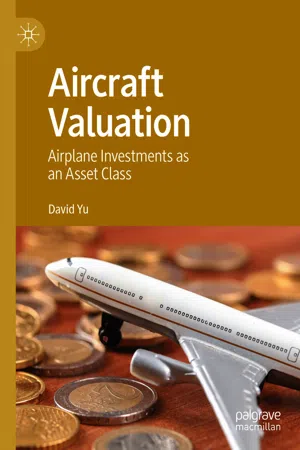The aircraft and aviation finance industry has seen large growth along with the overall aviation industry since the 1950s. It has developed from US- and European-centric origins to a more global and dynamic industry with many factors affecting the overall development. With regard to global growth, emerging markets stand out especially those of China and Asia. There has been tremendous growth in China, which has seen significant increases in all aspects of aviation financings, cross-border investment, and leasing activity. Overall, aviation finance is now a significant industry where global new aircraft deliveries worth well in excess of $126 billion are being invested annually in addition to investments in the secondary markets (Boeing Capital Corporation 2017).
Leasing, especially operating leasing, is a major driver in aircraft pricing and the asset class given it accounts for 43% of all global Airbus and Boeing and McDonnell Douglas aircraft as of 2017 (Ascend 2017). In Chap. 2, the core terms, concepts, and differences are defined including operating, finance leases, and their respective accounting and tax treatments under US GAAP (Generally Accepted Accounting Principles) and international accounting standards. The key difference between finance and operating leases is who retains the risk of ownership and residual value of the asset. There are further discussions of an example of operating lease cash flow structure. Why leasing is better compared to owning and its advantages and disadvantages from different perspectives and from practices are also discussed. There are upcoming changes and amendments in the accounting standards and treatments to leasing. These along with the effects on leasing are discussed.
The academic literature for leasing is quite extensive since the start of the academic discussions in the late 1950s and this is the basis of understanding for aircraft leasing and pricing. Academic arguments are based on the broader buy or lease question with additional variations and forms of the analysis including effects of leases, debt, and taxation on asset pricing, the firm, and much broader economic implications. There are gaps in the argument when it comes to an understanding of the driving factors determining aircraft pricing and leasing especially where it relates to characteristics of the global market and its segments. These characteristics describe the numerous drivers of the aircraft market and its effects on pricing. While numerous articles focus on smaller sections, this chapter extends the literature and ties together these different arguments.
While there are some early disagreements on theory and empirical investigations, eventually a general consensus is reached on the lease versus buy question, of which the effects of tax- and other non-tax-based influences are the main drivers, as shown by a long progression of article arguments (Wyman 1973; Lewellen et al. 1976; Roenfeldt and Osteryoung 1973; etc.). The other line of conversation is whether leasing and debt are complements or substitutes. While there are empirical findings supporting both, the latest papers show that they are more partial complements as there are circumstances that favor leasing (Bowman 1980; Ang and Peterson 1984; Finucane 1988; Lewis and Schallheim 1992; Yan 2006). While leasing is viewed initially as finance leases, there is a later trend to address it through the operating leasing context but at times the term is more ambiguously defined.
Asymmetric information has effects on leasing through tax differences and residual value knowledge (Krahan and Meran 1987; Lease et al. 1990; Edwards and Mayer 1991; Graham et al. 1998). Also, asymmetric information costs drive preference to leasing and this preference for leasing occurs if companies have better ratings and pay more dividends (Sharpe and Nguyen 1995). Also, the sale and leasebacks case is tax benefit driven and a method for companies to raise capital. Studies show that there are abnormally positive returns and this is due to the lowered tax expectation created by sale and leasebacks (SLBs) (Slovin et al. 1990; Handa 1991; Ezzell and Vora 2001). Operating lease SLB also supports the notion of expanded credit capacity (Schallheim et al. 2013).
Non-tax incentives for leasing are also investigated such as contractual provisions, increasing the firm’s debt capacity, managing credit ratings, and bankruptcy costs (Smith and Wakeman 1985; Vasigh et al. 2014; Eisfeldt and Rampini 2008; Lim et al. 2017; Krishnan and Moyer 1994). Real options and mathematical programming techniques are used to address different facets of leases and valuation. These include investigating residual value guarantees, asymmetry relationships, and valuation of operating leases (Schallheim and McConnell 1985; Sharpe and Nguyen 1995). There have been extensions of valuation methods for lease contracts and aircraft fleet decision-making (Stonier 1998, 1999, 2001; Bellalah et al. 2002; Clarke et al. 2003; etc.). Utilizing mathematical programming methods, airline decision-making in regard to buy, sale, and lease decisions showed the use of operating leases specifically for different types of airline business models (Hsu et al. 2011; Bazargan and Hartman 2012; Chen et al. 2018).
Chapter 3 reviews the dynamics, drivers, and outlook of the aviation finance and leasing landscape with respect to the global market. The overall drivers affecting the industry and aircraft pricing include demand, supply, and business model changes. Demand drivers include economic factors, business cycles, exogenous shocks, fuel prices, and traffic flows along with population demographics. Supply drivers include aircraft manufacturers, parked or retired aircraft, operating leases, secondary trading of aircraft, the financing environment along with current trends and segments such as commercial banks, capital markets, and export credit financing.
In addition, an analysis of the drivers affecting cross-border mergers and acquisitions in the industry is developed along with the characteristics of the increased use of leasing, specifically aircraft operating leasing. There are further discussions on the resurgence of sidecar joint ventures. The major global jurisdictions of aircraft leasing including Ireland, Singapore, Hong Kong, are also discussed. China is discussed in greater depth in Chap. 4. Tax and government incentives are shown as major drivers as well as other non-tax factors for leasing.
Chapter 4 is a more in-depth review of the Chinese market. This includes a discussion about the...
